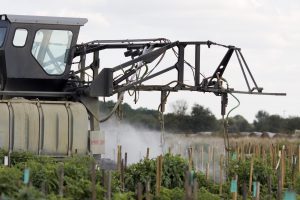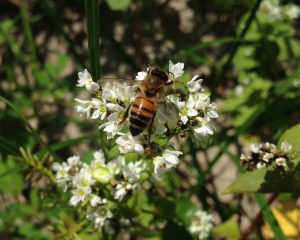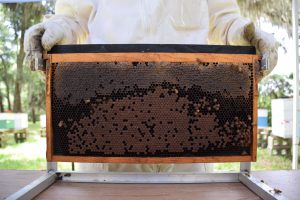Pesticides in Agriculture

Pesticides are an important tool for farmers to control unwanted insect pests. In recent years many commonly used pesticides have been shown to be dangerous to bees that they come into contact with. Honey bees and other beneficial insects can unintentionally be affected by pesticides, particularly if they are used improperly. It is important for all pesticide users to follow label instructions –the label is the law. The most widely used pesticides are the neonicitioids and they usually have a pollinator protection label that gives specific instructions for their proper usage. If used properly, one can minimize pesticide exposure to bees.
A New Compound
Due to the toxicity of some common pesticides to bees, pesticide manufacturers are constantly trying to develop safer alternatives. At the University of Florida Honey Bee Research and Extension Laboratory, we recently tested a new pesticide produced by Bayer Crop Science called SivantoTM on honey bee colony health. SivantoTM (active ingredient is flupyradifurone) has been shown to be very effective against insects with piercing/sucking mouthparts. One such insect is the Asian psyllid bug which is destroying Florida citrus trees. In lab trials, this pesticide had been shown to be less toxic to honey bees compared to other commonly used pesticides.

What We Did
For our experiment, we planted eight large fields of buckwheat. Buckwheat is a flowering crop that produces copious amounts of pollen and nectar that attract honey bees. Four fields were sprayed twice with SivantoTM at the highest label rate whereas the other four were left untreated. Three honey bee colonies were placed adjacent to each field and allowed to forage continuously during the flowering period. We measured honey bee colony strength parameters (e.g. # of adult bees, capped brood, uncapped brood, eggs, food stores) on all of the colonies during four time periods: prior to placement into the buckwheat fields, during the exposure period, 1 month after removal from the field, and 2 months after removal from the field. We also took pollen (bee bread) and nectar stores (unprocessed honey) from each hive to analyze for pesticide residue.


Results
Although we found higher pesticide residues within the pollen and nectar gathered from colonies placed adjacent to SivantoTM sprayed fields, we did not find any differences in any of the colony strength parameters between hives that foraged on buckwheat that had SivantoTM applied twice at the highest label rate and colonies placed near the untreated buckwheat fields. Our results indicated that SivantoTM is a promising systemic pesticide that has a favorable safety profile for honey bees and can be incorporated into integrated pest management programs for various crops in Florida.
This research was published in the Journal of Economic Entomology: http://dx.doi.org/10.1093/jee/tow186
 0
0
